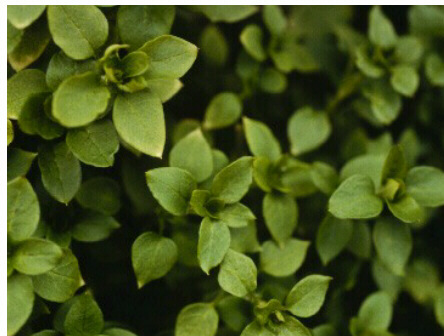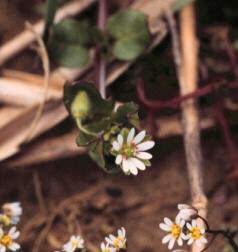
Chickweed

Blooms February through October
Annual or biennial
This is a low, loosely tangled mat of bright green stems and small ovoid leaves, with tiny, white, star-shaped flowers, and shallow, fibrous roots. Threadlike stems are smooth and succulent with a singe line of hairs traveling down one side until they meet a pair of leaves, at which point they become traitors and switch sides, and so on down the stem. The 6- to 18 inch stems lie prostrate except at the erect tips, and branch copiously.
The
simple oval leaves are pointed at the tips and smooth, though sometimes
hairy near the short petioles. The 1/2" to 1" leaves are sometimes
sessile and are spaced at wide intervals along the stem.
Flowers are white with five deeply divided petals, which give the appearance
of having ten. Hairy sepals are alternate and longer than the petals.
The flower is 1/8" to 1/4" wide. Chickweed is found in moist, shady
places--like under a leaky faucet on the north side of your house--in both
cultivated and wild areas throughout the temperate United States.

Chickweed is as harmless as it is versatile even when ingested in large amounts. It can be used fresh or dried (the dried herb will keep for up to 6 months). Pick the plant as soon as the dew has evaporated, remove the debris--there is always debris in this stuff--and dry it in a shallow box in a closet for a few days. Its demulcent, emollient, and anti-inflammatory properties make it the perfect remedy for eczema. When the eczema is weeping, dip a cloth into a very warm decoction of the herb and apply to the inflamed area as a compress until the heat dissipates to lukewarm. Keep replacing with the warmer compresses for 15 to 20 minutes three or more times a day. Likely only one day of this treatment is necessary to get past the weepy stage. Afterward, keep the area moist. A salve made from chickweed, olive oil, and beeswax is excellent for this.
The same salve, an infusion, or a poultice of the fresh plant can be used externally for chapped skin, itchy rashes, abrasions, inflammations, and skin ulcers. Drinking a chickweed infusion for several days to a few weeks will help clear up skin problems by cleansing the blood and kidneys. Its expectorant properties will help clear up a cough and rhinitis. Chickweed's refrigerant nature also helps to lower fevers. A decoction makes a gentle laxative and diuretic safe enough for children. And a fresh poultice will bring down swelling from sprains, arthritis, and gout, though this is most effective on small areas like wrists or fingers. Chickweed ointment can be used for the same purposes.
----------------------------------
Photos courtesy of Virginia Tech Weed Indentification Guide http://www.ppws.vt.edu/weedindex.htm
<--index